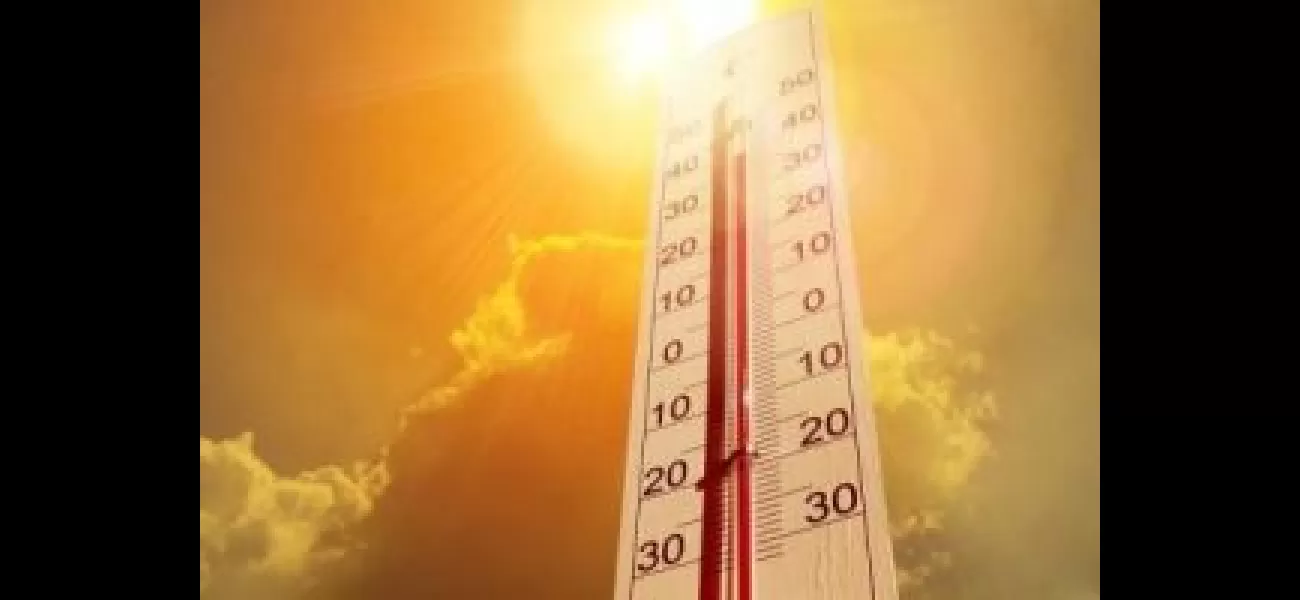Deadly heat wave in India reaches 50°C in Phalodi, Rajasthan.
"Temperatures hit 50 degrees in Phalodi, Rajasthan, as a heatwave grips India, making it challenging for voters in the ongoing elections."
May 25th 2024.

Temperatures in Rajasthan's Phalodi reached a scorching 50 degrees Celsius on Saturday, as a severe heatwave swept through large parts of India, putting the resilience of millions to the test. This extreme heat also affected the northern plains and central regions of the country, as well as the hills of Himachal Pradesh, Assam, and Arunachal Pradesh. Despite the unbearable heat, thousands of voters braved the conditions to participate in the sixth phase of the ongoing general elections, which covered 58 seats across eight states and Union territories, including Uttar Pradesh, Haryana, and the national capital.
In many places, voters stood in long lines without any shade for extended periods of time. Some polling booths even lacked basic necessities such as water, coolers, and chairs for the elderly, making the impact of the heat even more severe. In fact, some voters even fainted due to the extreme temperatures and hot winds in Delhi, where the mercury soared to over 45 degrees Celsius in six locations. This heatwave also broke records in other areas, with West Bengal's Cooch Behar, Assam's Silchar and Lumding, and Arunachal Pradesh's Itanagar and Pasighat recording their all-time high temperatures. Cities in Assam such as Tezpur, Mazbat, Dhubri, North Lakhimpur, and Mohanbari also saw record-breaking temperatures for the month of May.
According to official data, at least 17 places in Punjab, Haryana, Rajasthan, Uttar Pradesh, Gujarat, and Madhya Pradesh recorded maximum temperatures of 45 degrees Celsius or above on Saturday. In Rajasthan specifically, temperatures reached 48.8 degrees Celsius in Barmer, 48 degrees in Jaisalmer, and 47.2 degrees in Bikaner. This prompted the state's disaster management department to direct district collectors to make necessary arrangements to provide relief to people, animals, and birds from the scorching heat.
Unfortunately, the extreme heat is expected to continue in parts of Delhi, Rajasthan, Punjab, Haryana, Chandigarh, Uttar Pradesh, Madhya Pradesh, Gujarat, Chhattisgarh, and Maharashtra until May 29. It will also affect the hills of Himachal Pradesh, Assam, and Meghalaya. In fact, a 'red' warning has been issued for Rajasthan, Punjab, Haryana, Chandigarh, Delhi, west Uttar Pradesh, and Gujarat, indicating a "very high likelihood" of heat illness and heatstroke for all age groups. The India Meteorological Department (IMD) also warned that warm night conditions could further exacerbate heat-related stress in Uttar Pradesh, Punjab, Haryana, Delhi, and Rajasthan over the next four days.
The increasing nighttime heat is a common phenomenon in cities due to the urban heat island effect, where metropolitan areas are significantly hotter than their surroundings. Akash Vashishtha, founder-secretary of the Society for Protection of Environment and Biodiversity, explained that urban regions like Delhi-NCR become "heat chambers" due to land and surface concretization, which creates a heat multiplier effect. The concrete structures trap heat, resulting in significantly higher ambient temperatures. Vashishtha emphasized the need for immediate steps to keep ground surfaces vegetated to absorb solar radiation and reduce heat reflection and radiation from land surfaces.
The relentless heat in India is not only making daily life unbearable, but it is also taking a toll on power grids and water bodies. The Central Water Commission reported that water storage in 150 major reservoirs in India has hit a five-year low, exacerbating water shortages in many states and impacting hydropower generation. In the capital city of Delhi, the water levels in the Yamuna river have dropped significantly, affecting water supply. The city is also facing record power demands, with consumption reaching 8,000 megawatts on Wednesday as people use air conditioners, coolers, and refrigerators to cope with the heat.
The severe and frequent heatwaves are also disproportionately affecting low-income households, which often have poor access to water and cooling. This extreme heat is also testing the endurance of outdoor workers who toil in the scorching sun, forcing them to take frequent breaks. According to Anna Walnycki of the London-based International Institute for Environment and Development, low-income households have limited capacity to adapt to extreme heat due to poor access to water and electricity. The design and construction of informal houses also contribute to poor ventilation and offer little shelter from the heat.
Experts warn that outdoor workers, the elderly, and children are at a higher risk of heat exhaustion and heatstroke. The World Health Organisation reported that more than 166,000 people died as a result of heatwaves between 1998 and 2017. In India alone, 3,812 deaths were attributed to heatwaves between 2015 and 2022, with Andhra Pradesh recording the highest number of fatalities at 2,419. The punishing heat also has a significant impact on daily activities, with people becoming less productive and children struggling to learn.
Shyamal Santra of the NGO Transform Rural India highlighted the impact of heat on education, stating that studies have shown that students perform worse in tests during a "hot school year" compared to a "cool school year." This is particularly concerning in rural areas where 15% of government schools do not have a functional electricity connection and many are single-classroom schools. In addition to education, extreme heat also has a significant impact on agriculture and food production. Without adequate cold-chain infrastructure, fresh produce can be severely damaged by the heat. A World Bank report also warned that India could account for 34 million of the projected 80 million global job losses from heat stress-associated productivity decline by 2030.
In many places, voters stood in long lines without any shade for extended periods of time. Some polling booths even lacked basic necessities such as water, coolers, and chairs for the elderly, making the impact of the heat even more severe. In fact, some voters even fainted due to the extreme temperatures and hot winds in Delhi, where the mercury soared to over 45 degrees Celsius in six locations. This heatwave also broke records in other areas, with West Bengal's Cooch Behar, Assam's Silchar and Lumding, and Arunachal Pradesh's Itanagar and Pasighat recording their all-time high temperatures. Cities in Assam such as Tezpur, Mazbat, Dhubri, North Lakhimpur, and Mohanbari also saw record-breaking temperatures for the month of May.
According to official data, at least 17 places in Punjab, Haryana, Rajasthan, Uttar Pradesh, Gujarat, and Madhya Pradesh recorded maximum temperatures of 45 degrees Celsius or above on Saturday. In Rajasthan specifically, temperatures reached 48.8 degrees Celsius in Barmer, 48 degrees in Jaisalmer, and 47.2 degrees in Bikaner. This prompted the state's disaster management department to direct district collectors to make necessary arrangements to provide relief to people, animals, and birds from the scorching heat.
Unfortunately, the extreme heat is expected to continue in parts of Delhi, Rajasthan, Punjab, Haryana, Chandigarh, Uttar Pradesh, Madhya Pradesh, Gujarat, Chhattisgarh, and Maharashtra until May 29. It will also affect the hills of Himachal Pradesh, Assam, and Meghalaya. In fact, a 'red' warning has been issued for Rajasthan, Punjab, Haryana, Chandigarh, Delhi, west Uttar Pradesh, and Gujarat, indicating a "very high likelihood" of heat illness and heatstroke for all age groups. The India Meteorological Department (IMD) also warned that warm night conditions could further exacerbate heat-related stress in Uttar Pradesh, Punjab, Haryana, Delhi, and Rajasthan over the next four days.
The increasing nighttime heat is a common phenomenon in cities due to the urban heat island effect, where metropolitan areas are significantly hotter than their surroundings. Akash Vashishtha, founder-secretary of the Society for Protection of Environment and Biodiversity, explained that urban regions like Delhi-NCR become "heat chambers" due to land and surface concretization, which creates a heat multiplier effect. The concrete structures trap heat, resulting in significantly higher ambient temperatures. Vashishtha emphasized the need for immediate steps to keep ground surfaces vegetated to absorb solar radiation and reduce heat reflection and radiation from land surfaces.
The relentless heat in India is not only making daily life unbearable, but it is also taking a toll on power grids and water bodies. The Central Water Commission reported that water storage in 150 major reservoirs in India has hit a five-year low, exacerbating water shortages in many states and impacting hydropower generation. In the capital city of Delhi, the water levels in the Yamuna river have dropped significantly, affecting water supply. The city is also facing record power demands, with consumption reaching 8,000 megawatts on Wednesday as people use air conditioners, coolers, and refrigerators to cope with the heat.
The severe and frequent heatwaves are also disproportionately affecting low-income households, which often have poor access to water and cooling. This extreme heat is also testing the endurance of outdoor workers who toil in the scorching sun, forcing them to take frequent breaks. According to Anna Walnycki of the London-based International Institute for Environment and Development, low-income households have limited capacity to adapt to extreme heat due to poor access to water and electricity. The design and construction of informal houses also contribute to poor ventilation and offer little shelter from the heat.
Experts warn that outdoor workers, the elderly, and children are at a higher risk of heat exhaustion and heatstroke. The World Health Organisation reported that more than 166,000 people died as a result of heatwaves between 1998 and 2017. In India alone, 3,812 deaths were attributed to heatwaves between 2015 and 2022, with Andhra Pradesh recording the highest number of fatalities at 2,419. The punishing heat also has a significant impact on daily activities, with people becoming less productive and children struggling to learn.
Shyamal Santra of the NGO Transform Rural India highlighted the impact of heat on education, stating that studies have shown that students perform worse in tests during a "hot school year" compared to a "cool school year." This is particularly concerning in rural areas where 15% of government schools do not have a functional electricity connection and many are single-classroom schools. In addition to education, extreme heat also has a significant impact on agriculture and food production. Without adequate cold-chain infrastructure, fresh produce can be severely damaged by the heat. A World Bank report also warned that India could account for 34 million of the projected 80 million global job losses from heat stress-associated productivity decline by 2030.
[This article has been trending online recently and has been generated with AI. Your feed is customized.]
[Generative AI is experimental.]
0
0
Submit Comment





